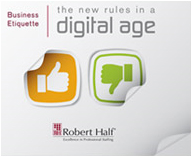New Business Etiquette Guide From Robert Half
![]() In the days when “tweets” were bird sounds and a “text” was a book, workplace blunders had a limited audience. Now, however, these missteps can receive broad exposure — with unhappy consequences: Three out of four (76 percent) human resources (HR) managers polled for a survey created by Robert Half and conducted via telephone by an independent research firm said technology etiquette breaches can affect a person’s career prospects.
In the days when “tweets” were bird sounds and a “text” was a book, workplace blunders had a limited audience. Now, however, these missteps can receive broad exposure — with unhappy consequences: Three out of four (76 percent) human resources (HR) managers polled for a survey created by Robert Half and conducted via telephone by an independent research firm said technology etiquette breaches can affect a person’s career prospects.
To prevent professionals from falling victim to online gaffes, Robert Half has released a new guide, Business Etiquette: The New Rules in a Digital Age. The comprehensive guide offers tips for successfully minding your manners when using professional networking sites, social media, e-mail, instant messaging, mobile devices and more. The company has also identified five common types of tech etiquette offenders and how to ensure you aren’t one of them.
More than 650 HR managers in the United States and Canada at companies with 20 or more employees were asked, “To what extent, if any, can technology etiquette breaches — for example, sending e-mail messages to unintended recipients, checking e-mail on a BlackBerry during meetings, etc., adversely affect a person’s career prospects?” 
HR responded with:
Greatly – 15%
Somewhat – 61%
Not at all – 23%
Don’t know – 1%
“Etiquette breaches, such as paying more attention to your smartphone than the people you’re meeting with, can make others feel less important and cause you to miss information,” said Brett Good, senior district president of Robert Half International. “Other mistakes, such as sending a confidential e-mail to the wrong person or impulsively posting an offensive comment on Facebook or Twitter, can have more serious, career-impacting consequences.”
Robert Half identified the top five technology etiquette breachers and gives advice to help workers avoid these labels:
1. The Venter. This indiscreet individual never misses an opportunity to document a bad work situation. Job-related gripes and groans get splashed across Facebook, Twitter and her personal blog. E-mail, too, takes a decidedly negative tone.
Advice: Look on the bright side. To avoid this label, keep the information that you post positive. Sticky or unpleasant situations are best discussed offline and in private.
2. The Noise Polluter. This person’s phone seems to lack a silent mode or an off button. Whether in a meeting or at a colleague’s desk, he freely takes and makes calls, oblivious to his surroundings. Between noisy ring tones and loud public broadcasts of personal conversations, it’s impossible to concentrate when he’s nearby.
Advice: To keep office noise at a minimum, set your phone to silent mode at the office, and hold personal conversations behind closed doors.
3. The Cryptic Communicator. This person relies on texting shorthand for every type of correspondence. Odd or informal abbreviations, poor punctuation, and spelling and grammatical goofs leave people shaking their heads — and pleading for clarification.
Advice: Slow down, and take it easy on the abbreviations. Spending a little more time on your communications can make them easier to decipher.
4. The Pop-Up Artist. While you’re trying to complete assignments, this chat fanatic insists on sending you a flurry of instant messages. Throughout the day, you’re subjected to the pings and pops of incoming IMs: RUTHERE? CYE [check your e-mail]!
Advice: IMs are fine for quick volleys of conversations, but don’t go overboard. And don’t expect that everyone will want to “chat” with you. For many, e-mail is immediate enough.
5. The Conference Call Con. This multi-tasker pretends to pay attention during teleconferences but is so busy checking e-mail he has no clue what’s being discussed. It’s not an unusual problem: 45 percent of executives confessed to frequently doing other things while in these meetings, according to another Robert Half survey.
Advice: Although we all multitask from time to time, pay attention to relevant conversations when on conference calls. It can help to turn away from your monitor so you’re not distracted by e-mail.



